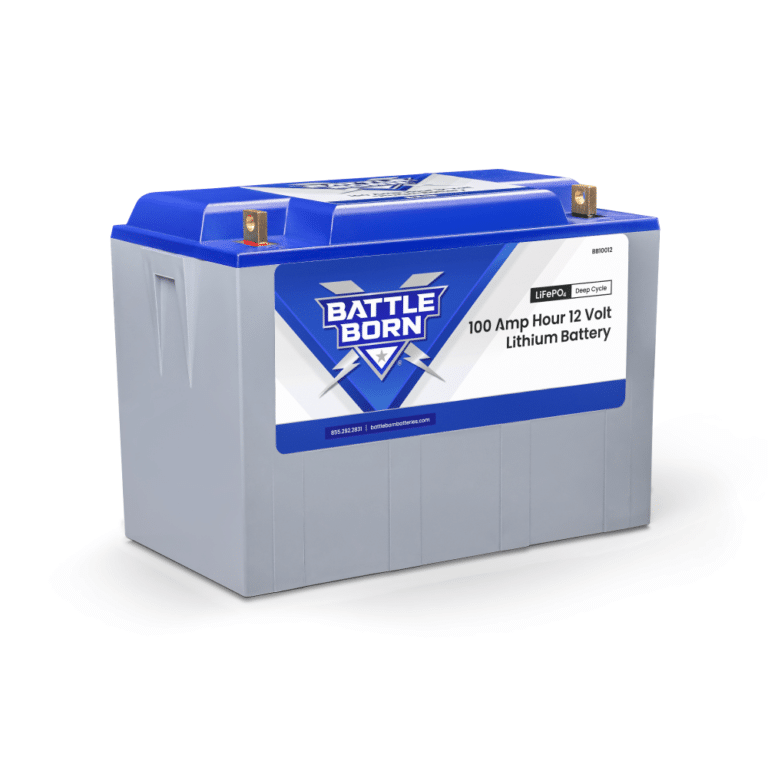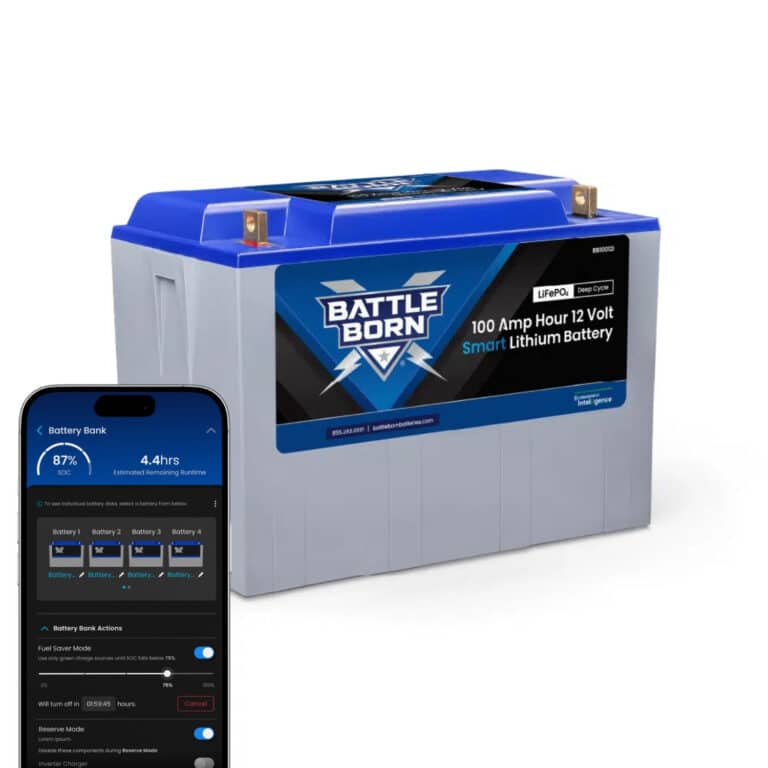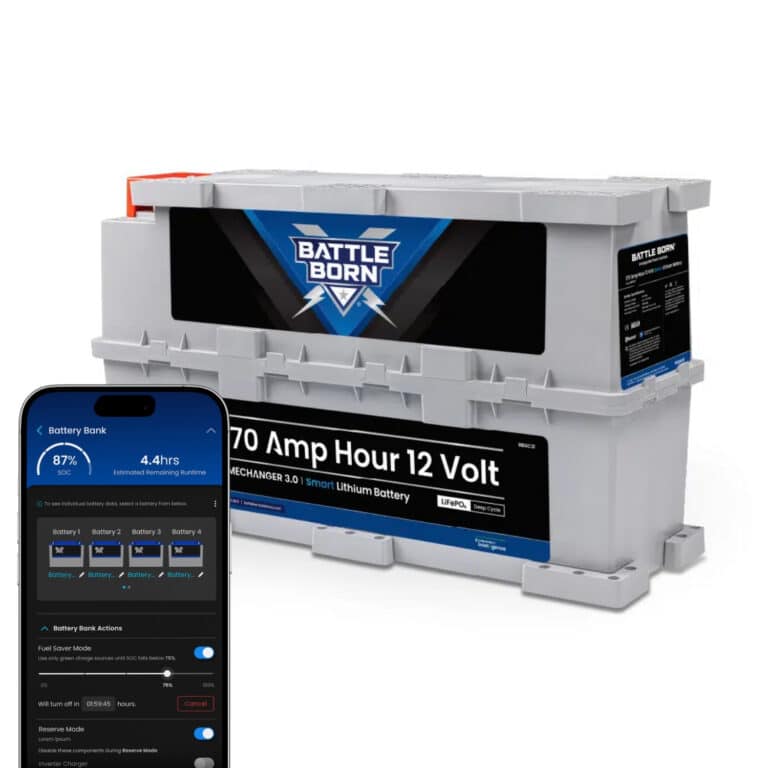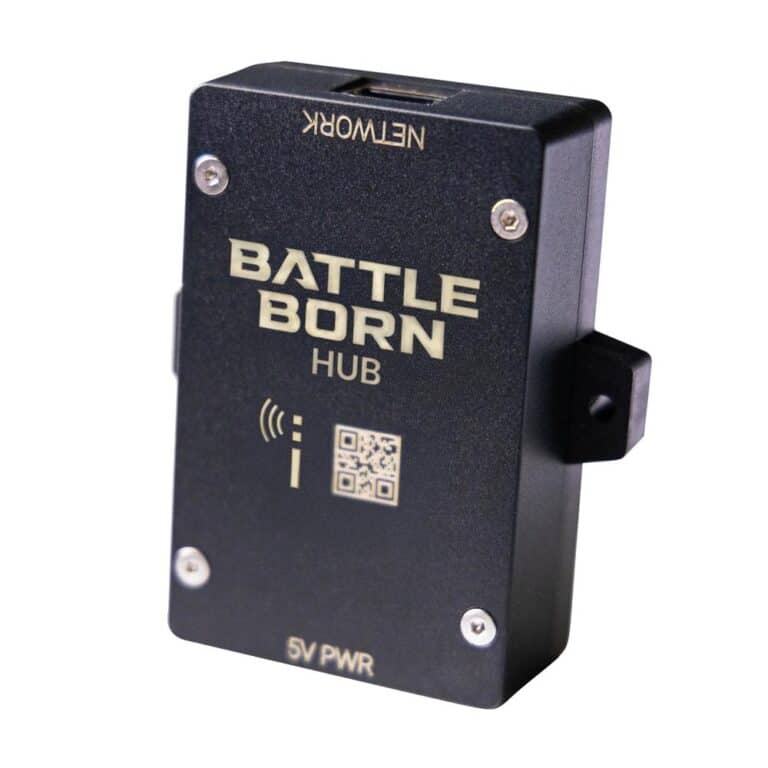
MENUMENU
TALK TO AN EXPERT
Special Hours: 7AM – 6PM PST
TALK TO AN EXPERT
Special Hours: 7AM – 6PM PST
As the temperatures drop and snow starts to fall, many people put their campers and boats in storage for the winter. They must perform proper winterization procedures to ensure their rigs are ready to go in the springtime. In addition to draining any standing water and shutting off appliances, Battle Born Batteries must be adequately winterized before being left in storage for an extended period. Let’s dive into what you must do to winterize and adequately store your Battle Born Batteries.
Bring the batteries to a full charge using shore power, generator, or lithium charger.
Disconnect Solar PV inputs from controllers.
Disconnect from shore power, generator, or lithium charger.
Disconnect the batteries from the system using your disconnect switch or removing the positive main battery cable.
Ensure that all system loads, including Smoke and CO detectors, must also be powered down.
If temperatures are expected to drop below -10 ° F where the batteries are being stored, remove them and store them in a warmer location.
If you are storing your entire system, we recommend using a battery guardian to help protect your batteries by disconnecting them from parasitic loads once they reach a voltage of 11.5V. We recommend removing the primary battery connections if a disconnect switch is not incorporated into your system since our batteries do not require a trickle charge. When you return to your rig in the warmer months, they should have plenty of power and are ready to go!
Battle Born Batteries have a meager self-discharge rate of 2-3% a month on average. Our batteries can handle a storage range of –15° F to 140° F.
Storing your batteries in subzero weather (-15° F or less) can potentially crack the ABS plastic and lead to a more significant loss of charge. When temperatures reach the extremes of cold and hot, they can self-discharge more than the average 3% monthly loss.
If the batteries are stored without a charge, their levels could dip below what the internal Battery Management System, or BMS, can protect over the winter season. We recommend storing them fully charged in an environment above freezing if possible. Our team recommends not leaving a completely drained battery in that state for an extended time, as it can damage the cells inside. Doing so will void the ten-year warranty that we offer with our products.
When discharging in frigid temperatures (less than 30° F), there is the potential for capacity loss in the batteries. The capacity is recoverable, and once the battery warms back up, it can return to its total amp hour rating. At 32° F, you’ll be able to discharge 80 Ah; at 0° F, you can expect a discharge of 70Ah. Additionally, charging a battery in extreme cold can cause lithium plating, a dangerous phenomenon that can lead to short-circuiting. Our batteries have protections that will not allow a charge if their internal temperature is less than 24°F.
Battle Born Batteries explored cold temperature charging in our industry-shaking White Paper study, where we put LiFePO4 batteries to the test against AGM. Despite being in less-than-ideal temperature ranges of 26°F-30°F, our batteries delivered 175Ah out of a 200Ah battery bank. The video below discusses how our batteries can outperform AGM in these cold conditions.
Building or upgrading an electrical system can be overwhelming, so we’re here to help. Our Reno, Nevada-based sales and customer service team is at (855) 292-2831 to answer your questions!
Also, join us on Facebook, Instagram, and YouTube to learn more about how lithium battery systems can power your lifestyle, see how others have built their systems, and gain the confidence to get out and stay out there.
Shop Best Sellers








Ask a technical specialist now at 855.292.2831
Stay in the Know
26 thoughts on “How to Winterize and Store LiFePO4 Batteries”
I store my RV for about 30-45 days at a time at most, and regardless of what switch I use to disconnect there is some parasitic load. I use a Magnum 2812 with the ME-ARC remote and a BMK. I have access to 110V power at my storage unit and I would like to program my unit for storage using CC/CV to bring the batteries to 80-90% and then let them slowly discharge to 20% and then recharge. I seem to lose about 2-3% SOC per day while in storage so this would cycle the batteries from 20-90% every 23-28 days or two charge cycles for my 45 day storage period. Can you recommend CC/CV settings that might get me close to those charge levels. Thanks for your time and advice.
Hello Douglas! Our team can’t really troubleshoot a parasitic load, but you can test it by shutting off breakers and seeing if you can isolate it to a specific circuit and then from that circuit try to identify which device is drawing from the batteries. As for the CC/CV you can set the CV charge volts to 14 volts so it doesn’t reach a full charge. Please set the Recharge volts to 12.9v so it will start to recharge at 20% SOC. You can contact us via phone at 855-292-2831 if you need further assistance on these settings.
When installing a battery disconnect, do you recommend it go on the positive or negative side?
Hi Gary! Our team says that either side is fine to install it on. They typically recommend that positive is best because it will cut off the battery bank and not add any resistance. If you have any additional questions, please let me know!
The inside battery switch on my 2020 Casita probably allows for some parasitic draw when in the off position. I am more curious, though, how much draw the “heat enable” wire to the battery itself will draw down the battery. If I put a battery disconnect switch at the battery itself, on the positive terminal, will it also shut down the heat enable without me having to unscrew it?
Hi Dave, thanks for reaching out. On average, the heated battery consumes an average of 1.8 amps. Our tests indicate that at 0 degrees Fahrenheit, with no insulation, the heater is on about 30% of the time. With no external charging or loads, it gives approximately 185 hours of heat capability before the battery goes into a low voltage disconnect. With warmer temperatures, you can consume less power and if you insulate your batteries you can extend the usage as well.
If you have any additional questions please refer to the FAQ section on our website here: https://battlebornbatteries.com/faq/ or give our technical sales team a call at 855-292-2831.
We have two dragonfly 100 amp hr batteries with heaters on them, a 300 watt solar panel on the roof of our fifth wheel camper. I alway put a cover on the camper. So what do I need to do to prepare for winter storage, if the batteries are left in the unit? With lead acid batteries, I generally took the batteries inside to the basement, put them on a piece of wood, then on a battery tender for the winter season. We live in Nebraska, and temps get down to 20 degrees and below frequently.
Hi Terry! We recommend bringing the Battle Born Batteries to a 100% charge and then disconnecting them completely for storage. The storage temperature range is -10°F to 140°F (-23°C to 60°C). After six months in storage your batteries will remain 75 – 80% charged. Storing batteries in subzero weather (-15°F or more) has the potential to crack the ABS plastic and more importantly could cause a faster loss of capacity, in some cases drastically more than the typical 2 – 4% per month loss.
All other Lipo4 battery brands say not to store them at 100% SOC , most say below 70 % but above 30 to keep them from going dead… Why do you all say 100%, do they not build heat like others ? that breaks down the battery overtime ?
Hi Chad. Unlike other LiFePO4 batteries that use prismatic cells, our batteries contain cylindrical cells. This means there is no worry of damaging the battery by fully charging or discharging it. Additionally, these cells are top-balancing, meaning once the batteries is fully charged the cells are balanced, this is why we recommend fully charging our batteries before storage. This way the cells are balanced during storage and fully charging the battery also allows the longest storage time.
I have owned Battle Born batteries for five years and find the self discharge rate to be virtually zero. I do as suggested by giving them a full charge, then turning the battery disconnect switch to the off position. I do leave the Victron BMV-712 battery monitor hooked up directly to the batteries so I can monitor them. When they finally drop down to a resting voltage of 13.30, they stay at that level for the 8 to 10 weeks my trailer is decommissioned though last year they actually dropped a whole 1/100th volt down to 13.29. Oh the horror! Lol
The Victron BMV-712 must sip current at an almost unmeasurable rate.
I have a B10012. Battle born dragonfly battery. New 2022. I’ve removed it from the trailer for winter ( Colorado Springs) what type of trickle charger should I use to keep it charged for the winter in the basement
Hi James! Our batteries don’t require trickle charging. We recommend bringing the Battle Born Batteries to a 100% charge and then disconnecting them completely for storage. After six months in storage your batteries will remain 75 – 80% charged, if stored at -10°F to 140°F (-23°C to 60°C).
Hello….I have a 100AH battle born battery. I can almost guarantee that I have been told by your reps to store it at 30%. Has that changed?
We recommend bringing Battle Born Batteries to a 100% charge and then disconnecting them completely for storage.
I have the option of hooking up my camper to shore power for the winter (Somers, MT) or not. With shore power, the batteries will stay continuously charged (unless we have some power failures). I could disconnect shore power, turn the battery switch off, and disconnect the battery cables as well.
Which do you recommend for 6 months of non-use?
We recommend bringing the Battle Born Batteries to a 100% charge and then disconnecting them completely for storage. After six months in storage your batteries will remain 75 – 80% charged. The storage temperature range is -10°F to 140°F (-23°C to 60°C).
Hi: I live in Minnesota and the temperature can get below -10 degress. I have a 2024 Airstream Basecamp 20X. What do you recommend for the batteries? Should I take them out of the RV,
Thanks
Hi Warren. If you are storing your RV for the winter we recommend bringing your Battle Born Batteries to a full charge, unplugging them, and storing them somewhere that won’t encounter subzero temperatures.
Hi. We have a Basecamp 20X with two battleborn batteries in it. It is in our driveway and connected to shore power. We have been keeping a lamp in the battery box in an effort to keep the temp above freezing. This weekend, we are experiencing 0 to -5f outside in the St. Louis area. The camper is at about 20 – 35* and the Battery Box has gotten down to 23*. Do I need to worry about the Batteries at these temperatures when they are connected to shore power?
It’s our first camper. We keep it plugged in because we are hoping to take it out one of these weekends and go south for a few days. Should I use the disconnect as outlined in forum, unhook a positive terminal, or just let them ride? There are three 100 watt solar panals on this basecamp as well.
Thanks.
When not in use, we recommend fully disconnected your batteries from all loads. They will no longer accept a charge when their internal temperature drops below 25°F. If temperatures will drop below zero, we also recommend ensuring the batteries are stored somewhere they won’t encounter sub-zero temperatures.
Hello, I am new to Battleborne, so I need some advice. I have a 2024 Tab 320 s with 180 w of solar on the roof. I plan on winter camping once a month for 3 nights at a time. Am I able to leave the battery in the trailer so it is ready to go or do I need to remove and install the battery each outing? I live in Southern Ontario so we can experience -25 Celsius or mild winters. Every year is different.
Thanks,
Ralph.
Hi Ralph! Is your Battle Born Battery heated?
Yes it is. There is a switch inside the trailer.
What’s the best way for me to “disconnect” my two Battle Born 100Ah 12V LiFePO4 batteries that are in series to winterize my NuCamp T@B 320? Can you provide a picture showing where to disconnect? (Or at least describe which color wires to disconnect?)
Thanks
Hi Jud! Our technical sales team would be happy to help you prepare your batteries for winter! You can reach them at (855) 292-2831 (M-F 8:00 am – 4:30 pm (PST)).